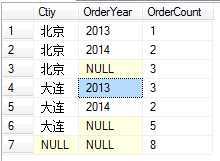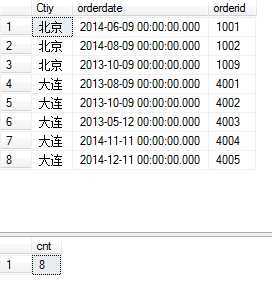标签:blog http io ar 使用 sp 数据 2014 on
今天用实例总结一下group by的用法。
归纳一下:group by:ALL ,Cube,RollUP,Compute,Compute by
创建数据脚本
Create Table SalesInfo
(Ctiy nvarchar(50),
OrderDate datetime,
OrderID int
)
insert into SalesInfo
select N‘北京‘,‘2014-06-09‘,1001
union all
select N‘北京‘,‘2014-08-09‘,1002
union all
select N‘北京‘,‘2013-10-09‘,1009
union all
select N‘大连‘,‘2013-08-09‘,4001
union all
select N‘大连‘,‘2013-10-09‘,4002
union all
select N‘大连‘,‘2013-05-12‘,4003
union all
select N‘大连‘,‘2014-11-11‘,4004
union all
select N‘大连‘,‘2014-12-11‘,4005
首先执行以下脚本:
select Ctiy,count(OrderID) as OrderCount
from
SalesInfo
group by Ctiy
with cube

可以看到多出了一行 是对所有的订单数的汇总
下一个脚本:
select Ctiy,Year(OrderDate) as OrderYear,count(OrderID) as OrderCount
from
SalesInfo
group by Ctiy,Year(OrderDate)
with cube

可以看出来对分组中的维度都进行了汇总,并且还有一个订单的总和
下一个脚本(注意出现了rollup):
select Ctiy,Year(OrderDate) as OrderYear,count(OrderID) as OrderCount
from
SalesInfo
group by Ctiy,Year(OrderDate)
with rollup

使用rollup会对group by列出的第一个分组字段进行汇总运算
下一个脚本:
select Ctiy,count(OrderID) as OrderCount
from
SalesInfo
where
Ctiy = N‘大连‘
group by all Ctiy
我们会看到 使用group by all 后,不符合条件的城市也会出现,只是订单数是零
需要注意的是 All 不能和 cube 和 rollup一起使用,和having一起使用的话,All的功能会失效.
下一个脚本:
select Ctiy,orderdate,orderid
from
SalesInfo
compute count(orderid)

显示了两个结果集,一个是订单结果集,一个是订单总数结果集
最后一个脚本:
select Ctiy,orderdate,orderid
from
SalesInfo
order by Ctiy
compute count(orderid) by Ctiy

按照不同的城市,分别显示该城市的订单信息,一个显示该城市的所有订单数量
就先说这些了.
标签:blog http io ar 使用 sp 数据 2014 on
原文地址:http://www.cnblogs.com/wanglg/p/4033106.html